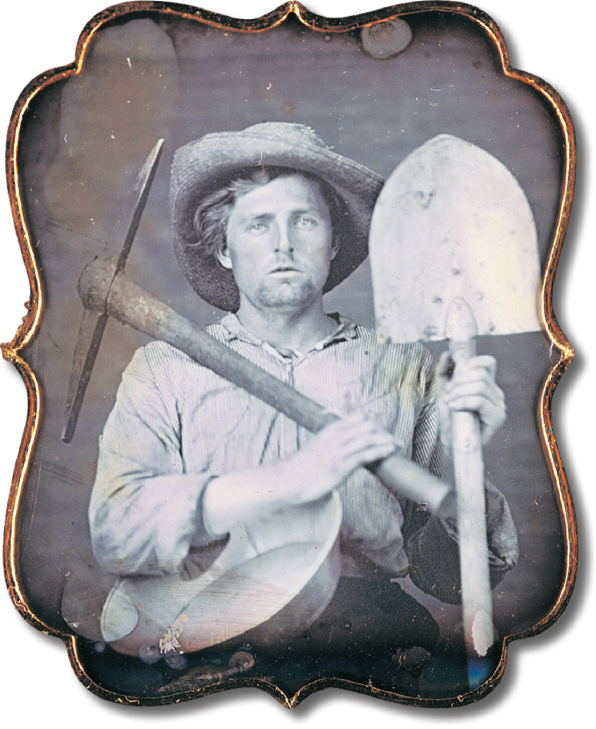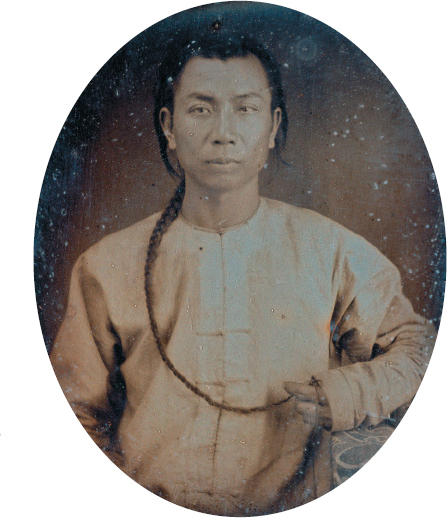Golden California
Printed Page 347
Another consequence of the Mexican defeat was that California gold poured into American, not Mexican, pockets. In January 1848, James Marshall discovered gold in the American River in the foothills of the Sierra Nevada. His discovery set off the California gold rush, one of the wildest mining stampedes in the world’s history. Between 1849 and 1852, more than 250,000 “forty-niners,” as the would-be miners were known, descended on the Golden State. In less than two years, Marshall’s discovery transformed California from foreign territory to statehood.
 Mining rush initiated by James Marshall’s discovery of gold in the foothills of the Sierra Nevada in 1848. The hope of striking it rich drew more than 250,000 aspiring miners to California between 1849 and 1852, an influx that accelerated the push for statehood.
Mining rush initiated by James Marshall’s discovery of gold in the foothills of the Sierra Nevada in 1848. The hope of striking it rich drew more than 250,000 aspiring miners to California between 1849 and 1852, an influx that accelerated the push for statehood.
Gold fever quickly spread around the world. A stream of men of various races and nationalities poured into California. Only a few struck it rich, and life in the goldfields was nasty, brutish, and often short. The prospectors faced cholera and scurvy, exorbitant prices for food (eggs cost a dollar apiece), deadly encounters with claim jumpers, and endless backbreaking labor.

Violent crime was an everyday occurrence, and establishing civic order was made more difficult by California’s diversity. The Chinese attracted special scrutiny from Anglos. By 1851, 25,000 Chinese lived in California, and their religion, language, dress, queues (long pigtails), eating habits, and use of opium convinced many Anglos that they were not fit citizens of the Golden State. In 1850, the California legislature passed the Foreign Miners’ Tax Law, which levied high taxes on non-Americans to drive them from the goldfields, except as hired laborers working on claims owned by Americans. The Chinese were segregated residentially and occupationally and, along with blacks and Indians, were denied public education and the right to testify in court.
Opponents demanded a halt to Chinese immigration, but Chinese leaders in San Francisco fought back. Admitting deep cultural differences, they insisted that “in the important matters we are good men. We honor our parents; we take care of our children; we are industrious and peaceable; we trade much; we are trusted for small and large sums; we pay our debts; and are honest, and of course must tell the truth.” Their protestations offered little protection, however, and racial violence grew.
CHAPTER LOCATOR
What factors contributed to the United States’ “industrial evolution”?
How did the free-labor ideal account for economic inequality?
What factors spurred westward expansion?
Why did the United States go to war with Mexico?
How did reform movements change after 1840?
Conclusion: How was white freedom in the West and North defined?
 LearningCurve
LearningCurve
Check what you know.
Anglo-American prospectors asserted their dominance over other groups, especially Native Americans and the Californios, Spanish and Mexican settlers who had lived in California for decades. Despite the U.S. government’s pledge to protect Mexican and Spanish land titles, Americans took the land of the rancheros and through discriminatory legislation pushed Hispanic professionals, merchants, and artisans into the ranks of unskilled labor. Mariano Vallejo, a leading Californio, said of the forty-niners, “The good ones were few and the wicked many.”

For Indians, the gold rush was catastrophic. Numbering about 150,000 in 1848, the Indian population of California fell to 25,000 by 1854. Starvation, disease, and a declining birthrate took a heavy toll. Indians also fell victim to wholesale murder. The nineteenth-century historian Hubert Howe Bancroft described white behavior toward Indians during the gold rush as “one of the last human hunts of civilization, and the basest and most brutal of them all.”
The forty-niners created dazzling wealth: In 1852, 81 million ounces of gold, nearly half of the world’s production, came from California. However, most miners eventually took up farming, opened small businesses, or worked for wages for the corporations that took over the mining industry. Others Americans traded furs, hides, and lumber and engaged in whaling and the China trade in tea, silk, and porcelain. Still, as one Californian observed, the state was separated “by thousands of miles of plains, deserts, and almost impossible mountains” from the rest of the Union. Some dreamers imagined a railroad that would someday connect the Golden State with the thriving agriculture and industry of the East. Others imagined a country transformed not by transportation but by progressive individual and institutional reform.
QUICK REVIEW
Question
What were the most significant consequences of the U.S. war with Mexico?